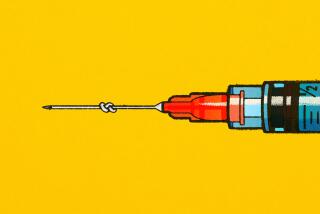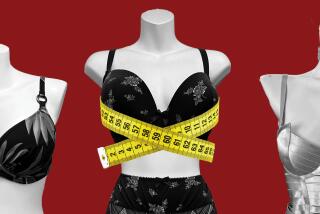FASHION : The Voluptuous Woman Makes a Comeback
- Share via
After 20 years of living with the thin, boyish body as the feminine ideal, the fashion world has renewed its fascination with the voluptuous figure.
Both haute couture and ready-to-wear have been marked by plunging necklines, filmy fabrics that wrap around the bosom, and push-up bras and padding--all intended to attract attention to the bust line. Madonna flaunts her shapely figure and is idolized by millions of young girls and women.
Breast implants have become the most popular cosmetic surgery for women in the country--more common than face lifts, nose jobs or liposuction. In the last decade, an estimated 2 to 3 million women have had saline or silicone implants to create curves they never had or to re-create those that time took away.
Breast implants are not cheap. The average price ranges from $1,900 to $2,500, and in California and New York, the cost is higher, sometimes reaching $6,000. What’s more, there are health risks associated with the procedure: ruptured implants, tumors, debilitating autoimmune reactions.
So why--after years and years of diets and man-tailored fashions--have fashion designers and growing numbers of women embraced the full figure with such a vengeance?
Most experts believe the new emphasis on a more traditional, ideal figure reflects a growing conservatism in American society. They point to what they say is a re-evaluation of the feminist movement and a retreat from the brains-not-body formula for success many career women adopted after the ‘60s. The trend also is being fueled by aging baby boomers, some of whom are fighting the signs of age.
Edward Maeder, curator of costumes and textiles for the Los Angeles County Museum of Art, cited the attack on abortion rights and the censorship of artists whose work is deemed “obscene” as examples of the increasing conservatism in America. And he predicted a backlash against the women’s movement. “Women are going to be completely repressed,” he says, by men who feel threatened by the gains women made in the ‘60s.
A more voluptuous figure--with its connotations of softness and motherhood--is far less intimidating to men than a lean, muscular woman in a business suit, Maeder said.
Susan Brownmiller, author of “Against Our Will: Men, Women and Rape,” said the current socio-political climate is a “retreat back to the values of the 1950s, and that wasn’t a good time for women.”
Brownmiller added: “Big breasts are celebrated when women lower their expectations in other areas and think how to be more physically attractive.” The popularity of breast implants, she said, indicates just how far women are willing to go to attract and appeal to men.
A buxom ideal of beauty is deeply rooted in Western culture, and male-created images of women--from ancient statues to Playboy pinup photos--have always glorified the breast.
But during the 1960s, as women struggled to be recognized as more than just wives and mothers, they rejected the sex-goddess role models. Curves were definitely out--at least as far as fashion was concerned.
Twiggy was hot; the boyish, androgynous look was in.
Fighting for equality in the workplace, women “resented guys talking about their bosoms,” said swimwear designer Anne Cole. “A woman didn’t want to be thought of as a sex object. That was just out.”
Now, “breasts are back because femininity is back,” said psychologist and former radio talk-show host Toni Grant.
Far from hiding women’s bodies, the latest fashions are designed to flaunt them. And they are being snapped up by women who no longer feel pressured to dress like men in a man’s world.
In Los Angeles, designer Robin Piccone of Body Glove swimwear has launched her own ready-to-wear collection of slip dresses and unitards with padded bust lines and built-in underwire bras. Van Buren’s Maggie Barry and Stephen Walker show padded corsets and bustiers to wear with bell-bottoms for spring. Anne Cole swimsuits have built-in push-up bras. (See swimwear story, E6).
Azzedine Alaia of Paris pioneered the trend. He showed push-up dresses and jackets with seaming that outlined the bosom at least five years ago.
Even designers of the most ladylike collections are following suit. New Yorker Donna Karan, the self-proclaimed proponent of sexy clothes for career women, was among the first to shift the accent to the bosom when she showed soft, sensual, pink cashmere sweaters that wrapped around the bodice. Italian designer Romeo Gigli created bosom-wrap dresses, with layers of filmy fabric draped around the bust line.
“Curves are natural to a woman’s form,” said Maggie Barry, whose slip dresses for Van Buren generally include built-in push-up bras. “Before, women were dieting to death to get rid of them, and now they are more at ease with them.”
Plastic surgeons who perform breast implants say most women seeking implants are not young, neurotic singles seeking to trap the perfect man, nor are they stylish beauty queens--obsessed with fashion and the dating scene--who consider implants another form of makeup.
Most women who undergo the surgery, the doctors say, are mature adults--women in their 30s, 40s and beyond, with varied life experiences, children, fulfilling jobs and, often, satisfying marriages.
But with small or drooping bust lines, they feel inadequate and insecure in a society where youth, beauty and breasts are ranked among a woman’s most important attributes.
“Most of these are serious women who don’t relish the cost and pain and discomfort of surgery,” said Dr. Gary Brody, a clinical professor of plastic surgery at the University of Southern California. “Fashion is so fleeting. Yes, the larger bosom seems to be popular, but it is more than just fashion.”
A survey conducted by the American Society of Plastic and Reconstructive Surgery of 380 women who had breast implants solely to improve their figures found that 62% were married at the time of their operations. Twenty-four percent were separated from their husbands and only 14% were single. Eighty-one percent were mothers.
Fifty-nine percent were over age 30 at the time of the surgeries, and 19% were over age 40. The average age of all breast implant patients was 33.
Melanie Gurk, 44, an office manager who lives in Santa Monica, recently went from “barely a 32-A” to a 34-C. Before her surgery, she said, her father used to say he “couldn’t tell the difference between the front or the back” when he looked at her. Her husband often joined in the jokes.
“It made me feel bad because I used to feel like, ‘I am what I am and I can’t do anything about that,’ ” Gurk said.
Her husband, she said, tried to reassure her that he found her attractive, but Gurk said she was not convinced.
“I wanted to believe him, but I thought, ‘How could you feel this way, you are an American male.’ What’s the first thing that men look at? When their eyes focus on a woman, it’s on her breasts,” she said.
But some observers of the fashion scene bemoan the breast fixation.
“People in this country idolize youth and form,” said Nina Blanchard, director of the prestigious modeling agency that bears her name. “It makes women crazy. In other countries, you don’t have to look like a 12-year-old to go out with a 50-year-old man.”
And Brownmiller believes “it is a tragedy that these women cannot live in their own bodies. Women’s bodies come in all different shapes and sizes and we have to learn to celebrate that.”






